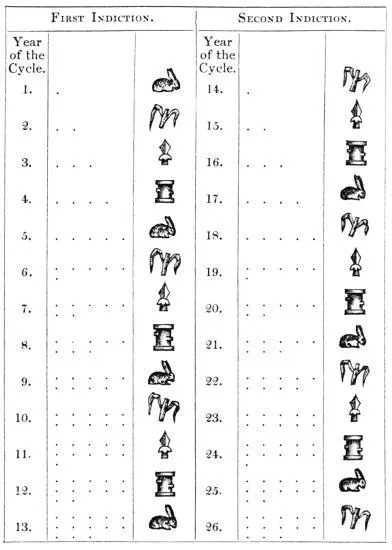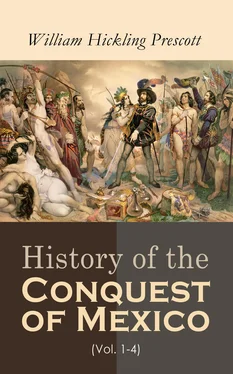[183]The Persians had a cycle of one hundred and twenty years, of three hundred and sixty-five days each, at the end of which they intercalated thirty days. (Humboldt, Vues des Cordillèras, p. 177.) This was the same as thirteen after the cycle of fifty-two years of the Mexicans, but was less accurate than their probable intercalation of twelve days and a half. It is obviously indifferent, as far as accuracy is concerned, which multiple of four is selected to form the cycle; though, the shorter the interval of intercalation, the less, of course, will be the temporary departure from the true time.
[184]This is the conclusion to which Gama arrives, after a very careful investigation of the subject. He supposes that the “bundles,” or cycles, of fifty-two years—by which, as we shall see, the Mexicans computed time—ended alternately at midnight and midday. (Descripcion, Parte 1, p. 52, et seq.) He finds some warrant for this in Acosta’s account (lib. 6, cap. 2), though contradicted by Torquemada (Monarch. Ind., lib. 5, cap. 33), and, as it appears, by Sahagun,—whose work, however, Gama never saw (Hist. de Nueva-España, lib. 7, cap. 9),—both of whom place the close of the year at midnight. Gama’s hypothesis derives confirmation from a circumstance I have not seen noticed. Besides the “bundle” of fifty-two years, the Mexicans had a larger cycle of one hundred and four years, called “an old age.” As this was not used in their reckonings, which were carried on by their “bundles,” it seems highly probable that it was designed to express the period which would bring round the commencement of the smaller cycles to the same hour, and in which the intercalary days, amounting to twenty-five, might be comprehended without a fraction.
[185]This length, as computed by Zach, at 365d. 5h. 48m. 48sec., is only 2m. 9sec. longer than the Mexican; which corresponds with the celebrated calculation of the astronomers of the Caliph Almamon, that fell short about two minutes of the true time. See La Place, Exposition, p. 350.
[186]“El corto exceso de 4hor. 38min. 40seg., que hay de mas de los 25 dias en el período de 104 años, no puede componer un dia entero, hasta que pasen mas de cinco de estos períodos máximos ó 538 años.” (Gama, Descripcion, Parte 1, p. 23.) Gama estimates the solar year at 365d. 5h. 48m. 50sec.
[187]The ancient Etruscans arranged their calendar in cycles of 110 solar years, and reckoned the year at 365d. 5h. 40m.; at least this seems probable, says Niebuhr. (History of Rome, Eng. trans. (Cambridge, 1828), vol. i. pp. 113, 238.) The early Romans had not wit enough to avail themselves of this accurate measurement, which came within nine minutes of the true time. The Julian reform, which assumed 365d. 5¼h. as the length of the year, erred as much, or rather more, on the other side. And when the Europeans, who adopted this calendar, landed in Mexico, their reckoning was nearly eleven days in advance of the exact time,—or, in other words, of the reckoning of the barbarous Aztecs;{*} a remarkable fact.—Gama’s researches led to the conclusion that the year of the new cycle began with the Aztecs on the ninth of January; a date considerably earlier than that usually assigned by the Mexican writers. (Descripcion, Parte 2, pp. 49-52.) By postponing the intercalation to the end of fifty-two years, the annual loss of six hours made every fourth year begin a day earlier. Thus, the cycle commencing on the ninth of January, the fifth year of it began on the eighth, the ninth year on the seventh, and so on; so that the last day of the series of fifty-two years fell on the twenty-sixth of December, when the intercalation of thirteen days rectified the chronology and carried the commencement of the new year to the ninth of January again. Torquemada, puzzled by the irregularity of the new-year’s day, asserts that the Mexicans were unacquainted with the annual excess of six hours, and therefore never intercalated! (Monarch. Ind., lib. 10, cap. 36.) The interpreter of the Vatican Codex has fallen into a series of blunders on the same subject, still more ludicrous. (Antiq. of Mexico, vol. vi. Pl. 16.) So soon had Aztec science fallen into oblivion after the Conquest!
{*} [See also Wilson, Prehistoric Man, i. p. 246.—M.]
[188]These hieroglyphics were a “rabbit,” a “reed,” a “flint,” a “house.” They were taken as symbolical of the four elements, air, water, fire, earth, according to Veytia. (Hist. antig., tom. i. cap. 5.) It is not easy to see the connection between the terms “rabbit” and “air,” which lead the respective series.{*}
{*} [The fleet and noiseless motions of the animal seem to offer an obvious explanation of the symbol.—K.]
[189]The following table of two of the four indictions of thirteen years each will make the text more clear. The first column shows the actual year of the great cycle, or “bundle.” The second, the numerical dots used in their arithmetic. The third is composed of their hieroglyphics for rabbit, reed, flint, house, in their regular order.

By pursuing the combinations through the two remaining indictions, it will be found that the same number of dots will never coincide with the same hieroglyphic. These tables are generally thrown into the form of wheels, as are those also of their months and days, having a very pretty effect. Several have been published, at different times, from the collections of Siguenza and Boturini. The wheel of the great cycle of fifty-two years is encompassed by a serpent, which was also the symbol of “an age,” both with the Persians and Egyptians. Father Toribio seems to misapprehend the nature of these chronological wheels: “Tenian rodelas y escudos, y en ellas pintadas las figuras y armas de sus Demonios con su blason.” Hist. de los Indios, MS., Parte 1, cap. 4.
[190]Among the Chinese, Japanese, Moghols, Mantchous, and other families of the Tartar race. Their series are composed of symbols of their five elements, and the twelve zodiacal signs, making a cycle of sixty years’ duration. Their several systems are exhibited, in connection with the Mexican, in the luminous pages of Humboldt (Vues des Cordillères, p. 149), who draws important consequences from the comparison, to which we shall have occasion to return hereafter.
[191]In this calendar, the months of the tropical year were distributed into cycles of thirteen days, which, being repeated twenty times,—the number of days in a solar month,—completed the lunar, or astrological, year of 260 days; when the reckoning began again. “By the contrivance of these trecenas (terms of thirteen days) and the cycle of fifty-two years,” says Gama, “they formed a luni-solar period, most exact for astronomical purposes.” (Descripcion, Parte 1, p. 27.) He adds that these trecenas were suggested by the periods in which the moon is visible before and after conjunction. (Loc. cit.) It seems hardly possible that a people capable of constructing a calendar so accurately on the true principles of solar time should so grossly err as to suppose that in this reckoning they really “represented the daily revolutions of the moon.” “The whole Eastern world,” says the learned Niebuhr, “has followed the moon in its calendar; the free scientific division of a vast portion of time is peculiar to the West. Connected with the West is that primeval extinct world which we call the New.” History of Rome, vol. i. p. 239.
[192]They were named “companions,” and “lords of the night,” and were supposed to preside over the night, as the other signs did over the day. Boturini, Idea, p. 57.
[193]Thus, their astrological year was divided into months of thirteen days; there were thirteen years in their indictions, which contained each three hundred and sixty-five periods of thirteen days, etc. It is a curious fact that the number of lunar months of thirteen days contained in a cycle of fifty-two years, with the intercalation, should correspond precisely with the number of years in the great Sothic period of the Egyptians, namely, 1491; a period in which the seasons and festivals came round to the same place in the year again. The coincidence may be accidental. But a people employing periodical series and astrological calculations have generally some meaning in the numbers they select and the combinations to which they lead.
Читать дальше













